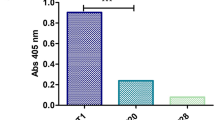Abstract
Specific targeting of tumor necrosis factor (TNF)-α antagonist to the inflamed site could increase its efficacy and reduce side-effects. Here, we constructed a bispecific diabody (BsDb) that targets TNF-α and ED-B-containing fibronectin, a fibronectin isoform specifically expressed in the pannus of the inflamed synovium in rheumatoid arthritis. BsDb was secreted from Pichia pastoris as functional protein and was purified to homogeneity. BsDb could simultaneously bind to human TNF-α and B-FN and neutralize TNF-α action. Additionally, BsDb showed a significant gain both in the antigen-binding affinity and in TNF-α-neutralizing ability as compared to its original antibodies, L19 and anti-TNF-α scFv, which were produced in E. coli. BsDb was constructed and was endowed with enhanced bioactivities and improved production processing. Therefore, it holds great potential for in vivo applications.




Similar content being viewed by others
References
Boeggeman EE, Ramakrishnan B, Qasba PK (2003) The N-terminal stem region of bovine and human beta1,4-galactosyltransferase I increases the in vitro folding efficiency of their catalytic domain from inclusion bodies. Protein Expr Purif 30:219–229
Chan AC, Carter PJ (2010) Therapeutic antibodies for autoimmunity and inflammation. Nat Rev Immunol 10:301–316
Claudepierre P, Allanore Y, Belec L, Larget-Piet B, Zardi L, Chevalier X (1999) Increased Ed-B fibronectin plasma levels in spondyloarthropathies: comparison with rheumatoid arthritis patients and a healthy population. Rheumatology 38:1099–1103
Cregg JM, Cereghino JL, Shi J, Higgins DR (2000) Recombinant protein expression in Pichia pastoris. Mol Biotechnol 16:23–52
Curtis JR, Yang S, Patkar NM, Chen L, Singh JA, Cannon GW, Mikuls TR, Delzell E, Saag KG, Safford MM, Duvall S, Alexander K, Napalkov P, Winthrop KL, Burton MJ, Kamauu A, Baddley JW (2014) Risk of hospitalized bacterial infections associated with biologic treatment among US veterans with rheumatoid arthritis. Arthritis Care Res 66:990–997
Kriegsmann J, Berndt A, Hansen T, Borsi L, Zardi L, Brauer R, Petrow PK, Otto M, Kirkpatrick CJ, Gay S, Kosmehl H (2004) Expression of fibronectin splice variants and oncofetal glycosylated fibronectin in the synovial membranes of patients with rheumatoid arthritis and osteoarthritis. Rheumatol Int 24:25–33
Liu M, Wang X, Yin C, Zhang Z, Lin Q, Zhen Y, Huang H (2006) One-step on-column purification and refolding of a single-chain variable fragment (scFv) antibody against tumour necrosis factor alpha. Biotechnol Appl Biochem 43:137–145
Liu M, Wang X, Yin C, Zhang Z, Lin Q, Zhen Y, Huang H (2007) Targeting TNF-alpha with a tetravalent mini-antibody TNF-TeAb. Biochem J 406:237–246
Liu M, Wang X, Yin C, Zhang Z, Lin Q, Zhen Y, Huang H (2008) A novel bivalent single-chain variable fragment (scFV) inhibits the action of tumour necrosis factor alpha. Biotechnol Appl Biochem 50:173–179
Macauley-Patrick S, Fazenda ML, McNeil B, Harvey LM (2005) Heterologous protein production using the Pichia pastoris expression system. Yeast 22:249–270
Rosenblum H, Amital H (2011) Anti-TNF therapy: safety aspects of taking the risk. Autoimmun Rev 10:563–568
Rosenfeld RD, Zeni L, Welcher AA, Narhi LO, Hale C, Marasco J, Delaney J, Gleason T, Philo JS, Katta V, Hui J, Baumgartner J, Graham M, Stark KL, Karbon W (1998) Biochemical, biophysical, and pharmacological characterization of bacterially expressed human agouti-related protein. Biochemistry 37:16041–16052
Trachsel E, Bootz F, Silacci M, Kaspar M, Kosmehl H, Neri D (2007) Antibody-mediated delivery of IL-10 inhibits the progression of established collagen-induced arthritis. Arthritis Res Ther 9:R9
Vollmer S, Vater A, Licha K, Gemeinhardt I, Gemeinhardt O, Voigt J, Ebert B, Schnorr J, Taupitz M, Macdonald R, Schirner M (2009) Extra domain B fibronectin as a target for near-infrared fluorescence imaging of rheumatoid arthritis affected joints in vivo. Mol Imaging 8:330–340
Zardi L, Carnemolla B, Siri A, Petersen TE, Paolella G, Sebastio G, Baralle FE (1987) Transformed human cells produce a new fibronectin isoform by preferential alternative splicing of a previously unobserved exon. EMBO J 6:2337–2342
Acknowledgments
This work was supported by grant of National Nature Science Foundation of China (30973669/H3004).
Author information
Authors and Affiliations
Corresponding author
Electronic supplementary material
Below is the link to the electronic supplementary material.
Rights and permissions
About this article
Cite this article
Liu, My., Hu, Xp., Xie, M. et al. Secretory expression of a bispecific antibody targeting tumor necrosis factor and ED-B fibronectin in Pichia pastoris and its functional analysis. Biotechnol Lett 36, 2425–2431 (2014). https://doi.org/10.1007/s10529-014-1630-2
Received:
Accepted:
Published:
Issue Date:
DOI: https://doi.org/10.1007/s10529-014-1630-2




